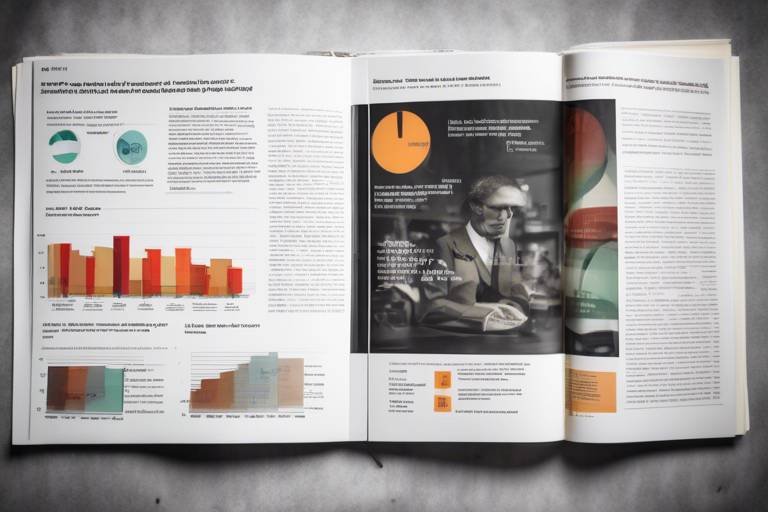Innovations in Systematic Review Methodologies
In the ever-evolving landscape of research, systematic reviews have emerged as a cornerstone for synthesizing evidence and guiding decision-making across various fields. With the advent of new technologies and methodologies, the traditional approaches to conducting systematic reviews are undergoing significant transformations. These innovations not only enhance the efficiency of the review process but also improve the accuracy and relevance of the findings. As we delve deeper into these advancements, it's essential to recognize their profound implications for researchers, policymakers, and practitioners alike.
One of the most exciting developments in systematic review methodologies is the integration of artificial intelligence (AI) and machine learning (ML)
Furthermore, the adoption of real-time data in systematic reviews is gaining traction. In a world where information is constantly changing, relying solely on static datasets can lead to outdated conclusions. By incorporating real-time data, researchers can ensure that their reviews reflect the most current evidence available. This is particularly crucial in rapidly evolving fields such as healthcare and technology, where timely information can inform critical decisions and policies.
As we explore these innovations, it becomes clear that they are not without challenges. For instance, the concept of dynamic literature updates allows for the continuous integration of new studies. This ensures that systematic reviews remain relevant and up-to-date. However, the influx of new information can lead to data overload, making it challenging for researchers to maintain the quality and integrity of their reviews. To navigate these complexities, establishing clear protocols and utilizing automated systems for literature monitoring are essential strategies.
Collaboration and crowdsourcing are other key elements that enhance the systematic review process. By pooling resources and expertise from diverse stakeholders, researchers can improve the depth and breadth of their reviews. This collaborative approach not only fosters innovation but also encourages a more comprehensive understanding of the topic at hand. Imagine a team of experts from various fields coming together to tackle a pressing research question—this synergy can lead to groundbreaking findings and insights.
In summary, the innovations in systematic review methodologies are transforming the way we conduct research. From the integration of AI and real-time data to the importance of collaboration, these advancements are paving the way for more efficient, accurate, and relevant evidence synthesis. As we embrace these changes, it is crucial to remain vigilant about the challenges they present and to develop effective strategies to overcome them. The future of systematic reviews is bright, and the potential for improved research quality and impact is immense.
In the realm of systematic reviews, the advent of artificial intelligence (AI) and machine learning (ML) is nothing short of revolutionary. Imagine having a team of tireless researchers who can sift through thousands of studies in mere seconds, extracting relevant data and identifying patterns that might take human analysts weeks or even months to uncover. This is the promise of AI and ML in systematic reviews. These technologies not only enhance the efficiency of the review process but also improve the accuracy of data extraction and analysis. But how exactly do they achieve this? AI algorithms are designed to learn from data and make predictions or decisions without being explicitly programmed for each task. In systematic reviews, this means that AI can be trained to recognize relevant studies based on predefined criteria, significantly reducing the time spent on literature searches. For instance, a recent study demonstrated that AI tools could identify pertinent articles with an accuracy rate of over 90%, which is a game changer for researchers who often face the daunting task of filtering through vast amounts of literature. Furthermore, machine learning models can continuously improve their performance as they are exposed to more data. This adaptability means that as new studies are published, the algorithms can refine their criteria and enhance their ability to detect relevant research. The result? A more streamlined process that keeps pace with the ever-growing body of scientific knowledge. However, while the integration of these technologies brings numerous benefits, it also raises important questions about trust and transparency. Researchers must ensure that the algorithms used in systematic reviews are not only effective but also understandable. After all, if a machine is making decisions about what studies to include, researchers need to know how those decisions are being made. This is where the concept of explainable AI comes into play, ensuring that the processes behind AI decision-making are transparent and justifiable. Moreover, AI and ML can also assist in the analysis phase of systematic reviews. By employing natural language processing (NLP), these technologies can analyze the content of studies, extracting key findings and synthesizing them into coherent summaries. This capability not only saves time but also enhances the quality of the synthesis by providing deeper insights into the data. As we look to the future, the potential for AI and ML in systematic reviews seems boundless. Imagine a world where researchers can conduct systematic reviews in real-time, with AI continuously scanning for new studies and updating the findings instantaneously. Such advancements could significantly impact fields like healthcare, policy-making, and education, where timely access to evidence is crucial for informed decision-making. In conclusion, the emergence of AI and machine learning technologies is transforming the landscape of systematic reviews. While challenges remain in terms of transparency and trust, the benefits of enhanced efficiency and accuracy are undeniable. As researchers continue to adopt these innovative methodologies, we can expect systematic reviews to become more dynamic, responsive, and ultimately, more valuable in guiding evidence-based practices across various fields. In today's fast-paced world, the ability to make informed decisions quickly is more critical than ever. This is where the into systematic reviews comes into play. Imagine trying to navigate a bustling city without a GPS—it's chaotic and inefficient. Similarly, researchers and policymakers need timely, relevant information to guide their decisions effectively. By incorporating real-time data into systematic reviews, we can enhance the relevance and applicability of research findings, ensuring they reflect the latest trends and developments. One of the significant advantages of using real-time data is its potential to inform decision-making and policy development. For instance, in the field of public health, real-time data can provide insights into emerging health threats, allowing for swift responses to outbreaks or health crises. This immediacy can be the difference between a well-managed situation and a full-blown emergency. Moreover, utilizing current information can lead to more tailored interventions that address the specific needs of populations at any given moment. However, integrating real-time data into systematic reviews isn't just about speed; it's also about enhancing accuracy and relevance. Traditional systematic reviews often rely on data that may become outdated by the time the review is published. In contrast, real-time data allows researchers to continuously update their findings, ensuring that the evidence presented is not only robust but also applicable to the current context. This dynamic approach can significantly improve the quality of the conclusions drawn from systematic reviews, making them more valuable for stakeholders. The concept of dynamic literature updates is a game-changer in the realm of systematic reviews. Instead of waiting months or even years for a review to be published, researchers can now continuously integrate new studies as they are released. This ensures that systematic reviews remain current and relevant, particularly in fast-evolving fields such as technology and medicine. For example, consider the rapidly changing landscape of COVID-19 research; having access to real-time data allows health officials to make informed decisions based on the latest findings. While the benefits of dynamic updates are clear, they do come with their own set of challenges. Managing data overload can be daunting. With a constant influx of new studies, researchers must develop efficient methods to sift through and evaluate the quality of this information. Additionally, ensuring the quality of newly incorporated studies is crucial; not all research is created equal, and it’s vital to maintain high standards even when updating literature dynamically. To effectively implement dynamic updates, researchers can adopt several strategies. Establishing clear protocols for data evaluation and integration is essential. Utilizing automated systems for literature monitoring can also significantly streamline the process. These systems can alert researchers to new publications, allowing them to focus on analysis rather than searching for the latest studies. By harnessing technology, researchers can keep their systematic reviews both current and relevant. In conclusion, the integration of real-time data into systematic reviews represents a significant advancement in research methodologies. Not only does it enhance the relevance and accuracy of findings, but it also empowers decision-makers with the information they need to act swiftly in an ever-changing landscape. As we continue to embrace this innovative approach, the potential for improved outcomes across various fields of study is immense. The world of research is constantly evolving, and staying updated with the latest findings is crucial for any systematic review. This is where the concept of comes into play. Imagine having a living, breathing document that evolves as new studies are published—this is the essence of dynamic updates. They allow researchers to continually integrate fresh data, ensuring that their reviews are not just snapshots of the past but are reflective of the most current evidence available. Dynamic literature updates are particularly valuable in fields where knowledge is rapidly changing, such as healthcare, technology, and environmental science. By incorporating new research as it becomes available, systematic reviews can provide more accurate and relevant conclusions. This approach not only enhances the credibility of the findings but also aids in making informed decisions that can significantly impact policy and practice. However, implementing dynamic updates is not without its challenges. The sheer volume of new studies being published can be overwhelming. Researchers may find themselves inundated with information, struggling to sift through the noise to find what is truly relevant. Additionally, there is the question of quality control—how do we ensure that the newly incorporated studies meet the rigorous standards required for systematic reviews? To tackle these challenges, researchers can adopt several strategies: In conclusion, dynamic literature updates represent a significant leap forward in systematic review methodologies. They offer a way to maintain the relevance and accuracy of reviews in an ever-changing landscape of research. As the integration of new studies becomes more streamlined, the potential for impactful research outcomes increases, paving the way for better decision-making in various fields. Dynamic updates in systematic reviews, while beneficial, come with a set of unique challenges that can complicate the process. One of the primary issues is the potential for data overload. As new studies are continuously integrated, researchers may find themselves inundated with information. This influx can make it difficult to discern which studies are most relevant and reliable, leading to a scenario where critical insights are lost in a sea of data. Moreover, the quality of newly incorporated studies can be a major concern. Not all research is created equal, and ensuring that only high-quality, peer-reviewed studies are included in the review is essential for maintaining the integrity of the findings. Researchers must establish robust criteria for evaluating the quality of new studies, which can be a time-consuming and subjective process. Another significant challenge is the need for consistent protocols. With dynamic updates, researchers must have clear guidelines in place to manage the integration of new literature. This includes determining when to update the review, how to incorporate new findings, and how to communicate these changes to stakeholders. Without established protocols, the review process can become chaotic, leading to confusion and potential errors in the final analysis. To tackle these challenges, researchers might consider implementing automated systems for literature monitoring. These systems can help streamline the process of identifying relevant new studies, allowing researchers to focus on analysis rather than data collection. However, even with automation, human oversight remains crucial to ensure that the quality of the information is not compromised. In summary, while dynamic updates offer the exciting potential to keep systematic reviews current and relevant, they also require careful management and rigorous standards to overcome challenges such as data overload, quality assurance, and protocol consistency. Addressing these challenges head-on is essential for leveraging the full benefits of dynamic updates in systematic reviews. Implementing dynamic literature updates in systematic reviews is not just about technology; it's about creating a robust framework that ensures quality and efficiency. To kick things off, establishing clear protocols is essential. Think of it like setting the rules for a game—everyone involved needs to know how to play to achieve the best outcome. These protocols should outline the criteria for selecting studies, the methods for data extraction, and the processes for integrating new literature. Without these guidelines, the review process can become chaotic, leading to inconsistencies and potential biases. Another key strategy is to utilize automated systems for literature monitoring. Imagine having a personal assistant who sifts through thousands of articles daily, flagging the ones that meet your criteria. This is precisely what automated systems can do. They can efficiently scan databases, alerting researchers to new studies that fit predetermined inclusion criteria. By automating this process, researchers can focus on analyzing data rather than getting bogged down in the minutiae of literature searches. Moreover, fostering collaboration among researchers can significantly enhance the implementation of dynamic updates. By pooling resources and expertise, teams can share the workload and insights, leading to richer and more comprehensive reviews. This collaborative spirit not only improves the quality of the reviews but also helps in addressing the challenges posed by data overload. When multiple experts contribute, they can better evaluate the relevance and quality of new studies, ensuring that only the best research is included in the systematic review. It's also vital to engage stakeholders throughout the process. This could include policymakers, practitioners, and even the public. By understanding their needs and preferences, researchers can tailor their systematic reviews to be more impactful and relevant. For example, if a systematic review is aimed at informing health policy, involving healthcare professionals in the early stages can provide invaluable insights that enhance the review's applicability. Finally, continuous training and education on the latest methodologies and technologies are crucial. The field of systematic reviews is rapidly evolving, and staying updated on best practices and new tools can make a significant difference in the quality of the reviews produced. Workshops, webinars, and online courses can be excellent resources for researchers looking to enhance their skills and knowledge in this area. In summary, implementing dynamic literature updates requires a multifaceted approach that includes clear protocols, automation, collaboration, stakeholder engagement, and ongoing education. By adopting these strategies, researchers can ensure that their systematic reviews are not only current but also of the highest quality, ultimately leading to better decision-making and improved outcomes across various fields. In the ever-evolving landscape of systematic reviews, the concepts of collaboration and crowdsourcing have emerged as powerful tools that can significantly enhance the review process. Imagine a world where researchers, practitioners, and even the public can come together to pool their collective expertise and resources to create more comprehensive and insightful reviews. This collaborative spirit not only enriches the research but also democratizes the process, allowing for a broader spectrum of perspectives and data to be considered. One of the most exciting aspects of collaboration in systematic reviews is the ability to harness the knowledge of diverse stakeholders. For instance, researchers from various disciplines can contribute their unique insights, leading to a more holistic understanding of the topic at hand. By working together, they can identify gaps in the literature, propose innovative methodologies, and ultimately produce more robust findings. This is especially beneficial in interdisciplinary fields, where the intersection of different areas of expertise can yield groundbreaking results. Crowdsourcing, on the other hand, allows for the gathering of data and insights from a larger pool of individuals, including those who may not traditionally be involved in academic research. This can include healthcare professionals, patients, or community members who have firsthand experience with the issues being studied. By integrating their voices into systematic reviews, researchers can ensure that the findings are not only academically rigorous but also relevant and applicable to real-world scenarios. However, while the benefits of collaboration and crowdsourcing are clear, they also come with their own set of challenges. For example, managing communication among a diverse group of contributors can be complex. Establishing clear roles and responsibilities is crucial to ensure that everyone is on the same page and that the review process remains organized. Additionally, there is the challenge of synthesizing different viewpoints and data sources into a cohesive narrative that accurately reflects the collective input. To effectively implement collaboration and crowdsourcing in systematic reviews, researchers can adopt several strategies: In conclusion, the integration of collaboration and crowdsourcing in systematic reviews holds immense potential to enhance the quality and relevance of research outcomes. By embracing these methodologies, researchers can create a more inclusive and comprehensive evidence synthesis process that not only advances academic knowledge but also addresses real-world challenges. Q1: What is the role of collaboration in systematic reviews? A1: Collaboration brings together diverse expertise and perspectives, enriching the review process and leading to more comprehensive findings. Q2: How does crowdsourcing contribute to systematic reviews? A2: Crowdsourcing allows for the inclusion of insights from a wider audience, including practitioners and community members, ensuring that the research is relevant and applicable. Q3: What are some challenges of implementing collaboration and crowdsourcing? A3: Challenges include managing communication, synthesizing diverse viewpoints, and ensuring organization throughout the review process. In the world of systematic reviews, play a pivotal role in shaping the credibility and reliability of research findings. With the ever-increasing volume of research being published, it’s essential that systematic reviews maintain a level of transparency that allows other researchers, practitioners, and policymakers to trust the conclusions drawn from them. The introduction of standards such as PRISMA 2020 has been a game-changer, ensuring that systematic reviews are not only comprehensive but also adhere to a set of guidelines that promote clarity and reproducibility. One of the primary advantages of improved reporting standards is the facilitation of comparative analysis. When researchers follow a standardized format, it becomes significantly easier to compare findings across different systematic reviews. This is especially crucial in fields where data is rapidly evolving, such as healthcare and environmental science. By adhering to these standards, researchers can ensure that their findings are not only valid but also comparable to others, which can lead to more robust conclusions and informed decision-making. Moreover, enhanced reporting standards help in promoting rigorous methodologies. When researchers are held to high standards, they are more likely to employ thorough and methodologically sound approaches in their reviews. This not only elevates the quality of individual studies but also contributes to the overall integrity of the research landscape. For instance, PRISMA 2020 emphasizes the importance of clearly stating the review's objectives, eligibility criteria, and the methods used for data synthesis. By doing so, it ensures that readers can easily assess the reliability of the findings presented. However, the implementation of these standards is not without its challenges. Many researchers may find the guidelines overwhelming or may lack the resources to adhere to them fully. This is where the role of training and support becomes vital. Institutions and organizations can provide workshops, resources, and tools to help researchers understand and implement these standards effectively. By investing in education around enhanced reporting, we can foster a culture of quality and transparency in systematic reviews. In conclusion, the significance of enhanced reporting standards cannot be overstated. They serve as a foundation for building trust in research findings, facilitating easier comparisons, and promoting rigorous methodologies. As the landscape of research continues to evolve, embracing these standards will be crucial for ensuring that systematic reviews are not only informative but also reliable. The future of evidence synthesis depends on our commitment to maintaining high reporting standards, and it’s a responsibility that researchers must take seriously. Standardization plays a pivotal role in the realm of systematic reviews, acting as the backbone that supports the integrity and reliability of research findings. When researchers adhere to standardized reporting guidelines, such as PRISMA 2020, they create a uniform framework that enhances clarity and comprehension. Imagine trying to piece together a puzzle where every piece is a different shape; without standardization, it would be nearly impossible to form a coherent picture of the evidence landscape. One of the primary benefits of standardization is that it fosters transparency in research. By following established protocols, researchers can ensure that their methodologies are clear and replicable. This transparency is crucial for building trust among stakeholders, including policymakers, practitioners, and the general public. When systematic reviews are conducted and reported consistently, it becomes easier for others to evaluate the quality of the research and its applicability to their own contexts. Furthermore, standardization facilitates easier comparisons between different systematic reviews. Consider a scenario where multiple reviews are conducted on the same topic but with varying methodologies. Without a standardized approach, it would be challenging to determine which findings are more robust or applicable. Standardized reporting allows researchers to present their findings in a way that can be readily understood and compared, ultimately leading to a more nuanced understanding of the evidence. Moreover, the impact of standardization extends beyond just clarity and comparability; it also enhances the overall quality of systematic reviews. When researchers adhere to best practices, they are less likely to overlook critical aspects of the review process, such as comprehensive literature searches or appropriate data synthesis methods. This adherence to rigorous standards can significantly elevate the reliability of the findings presented, ensuring that they accurately reflect the current state of knowledge in a given field. In summary, the importance of standardization in systematic reviews cannot be overstated. It not only promotes transparency and comparability but also enhances the overall quality and reliability of research findings. By embracing standardized reporting practices, researchers contribute to a more trustworthy and coherent body of evidence, ultimately benefiting the broader scientific community and society at large. The impact of enhanced reporting standards on research quality cannot be overstated. When researchers adhere to rigorous guidelines like PRISMA 2020, they not only improve the transparency of their systematic reviews but also bolster the credibility of their findings. This is akin to building a sturdy foundation for a house; without it, the structure may crumble under pressure. By ensuring that every step of the review process is documented and standardized, researchers can provide a clear roadmap of their methodologies, which allows others in the field to replicate their work or build upon it. Furthermore, improved reporting standards facilitate easier comparisons across different studies. Imagine trying to compare two recipes without knowing the exact measurements and cooking times; it would be nearly impossible to determine which one is better. Similarly, when systematic reviews follow standardized reporting, it becomes much simpler for researchers to assess the quality and relevance of various studies. This not only enhances the integrity of the research but also fosters a collaborative spirit within the scientific community, as researchers can confidently cite and rely on each other's work. In addition to fostering collaboration, enhanced reporting standards can significantly elevate the overall quality of systematic reviews across various disciplines. For instance, when researchers follow established guidelines, they are more likely to identify potential biases in their studies, address them proactively, and report their findings transparently. This rigorous approach not only minimizes the risk of misleading conclusions but also enriches the body of knowledge in a particular field. As a result, stakeholders—including policymakers, practitioners, and the general public—can make better-informed decisions based on high-quality evidence. To put this into perspective, let's consider a table that highlights the differences in research quality before and after the implementation of enhanced reporting standards: In conclusion, the impact of enhanced reporting standards on research quality is profound. By promoting rigorous methodologies and encouraging transparency, these standards not only improve the reliability of systematic reviews but also create a more trustworthy and collaborative research environment. As we continue to advance in our understanding of various fields, adhering to these enhanced standards will be crucial in ensuring that our findings are not only credible but also actionable. Systematic reviews are comprehensive surveys of existing research on a specific topic. They are crucial because they synthesize findings from multiple studies, providing a clearer picture of the evidence and helping to inform decisions in policy and practice. Emerging technologies, particularly artificial intelligence and machine learning, are revolutionizing systematic reviews by automating data extraction and analysis. This enhances efficiency and accuracy, allowing researchers to focus on interpreting results rather than getting bogged down in data collection. Integrating real-time data allows systematic reviews to reflect the most current information available. This is vital for decision-making and policy development, especially in fast-paced fields like healthcare and technology, where new findings can rapidly change the landscape. Dynamic literature updates involve continuously integrating new studies into systematic reviews. This ensures that the reviews remain relevant and up-to-date, providing stakeholders with the latest evidence without the need for a complete overhaul of the review process. While dynamic updates are beneficial, they come with challenges such as managing data overload and ensuring the quality of new studies. Researchers must develop strategies to filter and assess the relevance and reliability of incoming research. Collaboration and crowdsourcing can enhance systematic reviews by pooling resources and expertise from various stakeholders. This collective approach can lead to more thorough and diverse analyses, ultimately improving the quality of the review outcomes. Enhanced reporting standards, such as PRISMA 2020, are guidelines that ensure transparency and reproducibility in systematic reviews. They help researchers adhere to best practices, which fosters trust in the findings and makes it easier to compare results across different studies. Standardization in reporting is important because it helps researchers follow consistent methodologies, facilitating easier comparisons and synthesis of findings. This ultimately leads to higher quality research and more reliable conclusions. Improved reporting standards can significantly elevate the overall quality and reliability of systematic reviews. By promoting rigorous methodologies, these standards ensure that findings are credible and can be trusted by policymakers, practitioners, and the public.
Systematic reviews are comprehensive surveys of existing literature on a specific topic, aimed at synthesizing evidence to inform decision-making.
AI enhances the efficiency and accuracy of data extraction and analysis, allowing researchers to process large volumes of studies quickly.
Dynamic literature updates allow for the continuous integration of new studies, ensuring that systematic reviews remain current and relevant.
Collaboration pools resources and expertise, leading to more comprehensive and innovative research outcomes.
Emerging Technologies in Systematic Reviews

Integration of Real-Time Data
Real-time data integration involves continuously updating systematic reviews with the latest research findings to ensure that conclusions are based on the most current information available.
By providing timely insights, real-time data allows policymakers and researchers to make informed decisions that reflect the current state of knowledge and emerging trends.
Challenges include managing data overload and ensuring the quality of new studies incorporated into systematic reviews.
Establishing clear protocols and utilizing automated literature monitoring systems are effective strategies for integrating real-time data into systematic reviews.
Dynamic Literature Updates

Challenges of Dynamic Updates
Dynamic updates refer to the continuous integration of new research findings into systematic reviews, allowing them to stay current and relevant as new studies are published.
Key challenges include data overload, quality assurance of new studies, and the need for consistent protocols for integrating new literature.
Researchers can implement automated systems for literature monitoring and establish clear guidelines for evaluating the relevance and quality of new studies.
Ensuring the quality of newly incorporated studies is crucial for maintaining the integrity and reliability of the systematic review's findings.
Strategies for Implementation

Collaboration and Crowdsourcing

Enhanced Reporting Standards

Importance of Standardization
Systematic reviews are comprehensive surveys of existing research on a specific topic, designed to synthesize findings and provide insights into the current state of knowledge.
Standardization is crucial as it ensures transparency, facilitates comparisons, and enhances the overall quality and reliability of the research findings.
PRISMA 2020 is a set of guidelines that provide a framework for reporting systematic reviews and meta-analyses, aimed at improving the quality of research reporting.
By promoting adherence to best practices, standardization helps prevent methodological errors and enhances the reliability of systematic reviews.
Impact on Research Quality
Aspect
Before Enhanced Standards
After Enhanced Standards
Transparency
Limited documentation of methodologies
Comprehensive reporting of methods and findings
Reproducibility
Difficult to replicate studies
Higher likelihood of reproducible results
Bias Identification
Potential biases often overlooked
Proactive identification and reporting of biases
Collaboration
Isolated studies with little cross-referencing
Enhanced collaboration and citation among researchers
Frequently Asked Questions


















